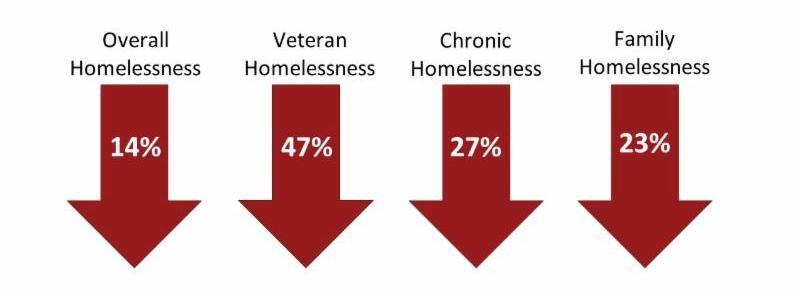Continuing to Drive Progress in Ending Homelessness

This week, the U.S. Department of Housing and Urban Development released its annual Point-in-Time count results, reporting steady reductions in homelessness between 2010 and 2016. A more detailed analysis of this data will be available in the weeks ahead, but in the meantime, we encourage everyone to:
Read the Annual Homeless Assessment Report to Congress, Part I.
Read HUD's press release about the Point-in-Time data.
Here are the remarks from Executive Director Matthew Doherty on the 2016 Point-in-Time Count Data
"At the U.S. Interagency Council on Homelessness we find this data, on the whole, very encouraging. We've steadily reduced homelessness since Opening Doors was launched in 2010. The arrows are pointing in the right direction. But we can and must do even better.
About the Data
This data in this report is based on data gathered and submitted by communities across the country through their local counts.
Such point-in-time data provides us with a snapshot of the estimated number and demographics of people who are experiencing homelessness at a given point of time - in this case, from about 11 months ago, January 2016.
This data helps to estimate how much day-to-day capacity we need within our homelessness crisis response systems. And it also helps us assess the impact of our strategic activities up until that point.
But it is not the only data that we consider, and it is not the only data that communities should use to guide the strategic decisions and tailor the interventions that we need to end homelessness.
We also need to consider sources of annualized data that help us understand the number of people who experience homelessness or housing instability over the course of a year. Such data helps paint a more complete picture of the state of homelessness and housing needs in our country.
There are a couple of key sources of such data:
- Last month, HUD released part II of its 2015 Annual Homeless Assessment Report to Congress based upon Homeless Management Information System data, which documents the number of people who experience homelessness in shelters over the course of the year. This data showed that between 2014 and 2015, the number of people experiencing sheltered homelessness at some point during the reporting year remained roughly the same, declining by less than 1%.
- For understanding the scope and scale of homelessness among youth and families with children, we also closely consider the data gathered by schools for the Department of Education. This annualized data documents the number of children enrolled in public schools who are identified as experiencing homelessness at some point during the school year - including children who are living in shelters or who are unsheltered - and also includes children who may be staying in motels or in doubled-up arrangements. This data showed an 8% increase between the 2013 and 2014 school years, and we'll be looking closely at what the 2015 data tells us.
The Work Ahead
But our work is clearly not done, so I also wanted to talk about a few of the things we need to be urgently focusing on in the months and years ahead to pick up the pace of our progress.
We must increase the supply of affordable housing. We must continue to target and prioritize existing affordable housing to people exiting homelessness, but we must also take steps to increase the overall supply of housing units within our communities. Jurisdictions need to remove local barriers to housing development that have reduced the ability of many housing markets to respond to growing demand. And we must invest in new affordable housing across all levels of government.
We must continue to improve connections to mainstream programs and employment services and opportunities. To both prevent homelessness, and to ensure the success and stability of people who are experiencing or have exited homelessness, we must do more to connect people to health and social services, and to integrate employment services and opportunities into our housing and services systems.
And finally, we must maintain partnerships at all levels of government. To sustain the progress we've made to date, we must continue to pursue a collaborative approach across federal, state, and local government. And we must sustain our investments into the strategies and programs that are working, knowing that our communities must have lasting systems that are poised to respond to crisis every day.
As always, we thank you for your dedication to making sure every American has a safe and stable home."
For Media Inquiries Contact
Libby Foster
lfoster@housingforward.org
708.338.1724 ext 211



